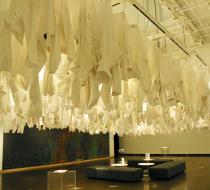A Haunting Artistic Tribute to Garment Workers Killed in Bangladesh and the US 1 Favorite
NORTHFIELD, Minn. — Exactly 1,281 white garments hang from the ceiling of the Perlman Teaching Museum’s Braucher Gallery. The collared shirts, knit sweaters, tights, and other items of clothing glow with an eerie luminosity.
The 1,281 garments represent the number of Bangladeshi garment workers killed in the Rana Plaza building collapse in 2013, as well as the New Yorkers killed in the Triangle Shirtwaist Factory fire in 1911. Both incidents, which happened 102 years apart on different continents, tragically illustrate the dangerous conditions workers who make cheap clothing have faced and continue to face.
They also were highly publicized incidents that spurred change within the industry. The Triangle Shirtwaist Fire spurred a strengthening of the labor movement in the US, while the Rana Plaza collapse led to the formation of the Alliance for Bangladesh Worker Safety, an organization made up primarily of US clothing brands including Gap Inc., Walmart and Target, according to PBS News Hour. Meanwhile, western clothing companies have increased their purchases from Bangladeshi factories since the Rana Plaza collapse, with Bangladeshi garment exports reaching $28.1 billion last year according to the Financial Times.
At the Perlman Teaching Museum, the shroud of clothes is part of The Price of Our Clothes, an installation created by visual artist Rachel Breen and poet Alison Morse. When the Rana Plaza collapse happened, they both immediately knew it was the project on which they should collaborate. Morse had family members who had been garment workers when they emigrated to the US from Russia, and Breen had long been interested in social justice as part of her artistic practice. “Part of being Jewish is being an activist and working for social change,” she said. Both artists were interested in making the connection between the two worker catastrophes clear to American consumers.
In 2015, they traveled to Dhaka, Bangladesh, where they conducted interviews with activists, and garment workers, including survivors of the Rana Plaza collapse, documenting their trip on a blog. They also researched the Triangle Shirtwaist fire, drawing on interviews from survivors and witnesses that are used in the installation.
Beneath the enormous shroud of clothes, which takes up the entire ceiling of the gallery, benches are laid out in the center of the room. There, visitors feel the weight of the shroud hanging over them, and take in Breen’s pastel wall drawing, made from stencils created by an unthreaded sewing machine. The drawing incorporates floor plans of the Triangle Shirtwaist and Rana Plaza factories, as well as shapes of fabric scraps the artists collected during their trip to Bangladesh. Visitors can also call different telephone numbers and listen to sound pieces created by Morse, including recordings of interviews, poems, and sound collages.
On the opposite wall from the drawing, as well as at several stands throughout the gallery, are Morse’s poems, which often take on the voices of people affected by the two disasters. She also weaves in her own role as a consumer of clothes, faced with making choices in our consumerist society. Morse’s work incorporates vivid descriptions of things the two artists saw on their trip and gathered from their research.
In this poem, ACTIVIST means Kalpona Akter, but
I AM A WOMAN, HUMAN is what Kalpona says.
Her bicycle leans against the wall
by her office desk. Her wide smile embraces me.
— from Alison Morse’s “ACTIVIST MEANS”
On April 2, Breen conducted a performance of sorts outside of the gallery, in the lobby of Carleton College’s Weitz Center for Creativity. There, she spent two three-hour sessions sewing garments in the shape of the uniforms she saw women wear in the factories of Bangladesh. She chatted with students and other passersby about the project, encouraging folks to get more information about the ethics of our shopping choices.
“When we were there, it dawned on me that women working in incredibly unsafe conditions with unfair pay would never wear the same clothes that we wear,” she said. “In some ways it’s quite tedious,” Breen said of her performance. “Part of the idea is to emphasize that this is an incredibly tedious and repetitive task that women are doing.”
An additional performance will take place on April 12, which will involve Morse and other performers reading her poems, as well as poets Anh-Hoa Thi Nguyen, Bridget Murphy, and Kate Kysar reading their own poems.












